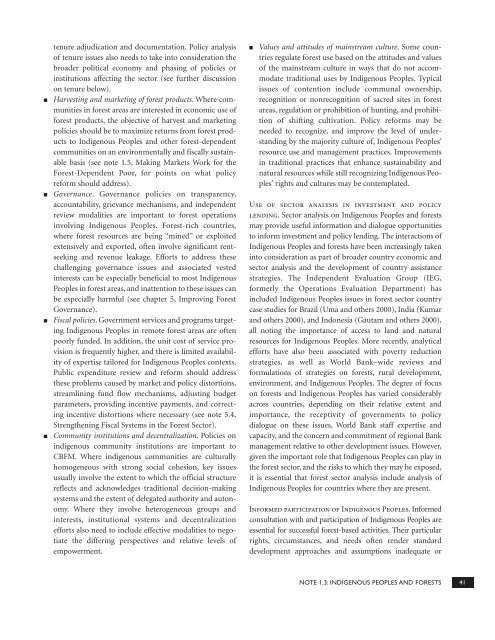Forests Sourcebook - HCV Resource Network
Forests Sourcebook - HCV Resource Network
Forests Sourcebook - HCV Resource Network
Create successful ePaper yourself
Turn your PDF publications into a flip-book with our unique Google optimized e-Paper software.
■<br />
■<br />
■<br />
■<br />
tenure adjudication and documentation. Policy analysis<br />
of tenure issues also needs to take into consideration the<br />
broader political economy and phasing of policies or<br />
institutions affecting the sector (see further discussion<br />
on tenure below).<br />
Harvesting and marketing of forest products.Where communities<br />
in forest areas are interested in economic use of<br />
forest products, the objective of harvest and marketing<br />
policies should be to maximize returns from forest products<br />
to Indigenous Peoples and other forest-dependent<br />
communities on an environmentally and fiscally sustainable<br />
basis (see note 1.5, Making Markets Work for the<br />
Forest-Dependent Poor, for points on what policy<br />
reform should address).<br />
Governance. Governance policies on transparency,<br />
accountability, grievance mechanisms, and independent<br />
review modalities are important to forest operations<br />
involving Indigenous Peoples. Forest-rich countries,<br />
where forest resources are being “mined” or exploited<br />
extensively and exported, often involve significant rentseeking<br />
and revenue leakage. Efforts to address these<br />
challenging governance issues and associated vested<br />
interests can be especially beneficial to most Indigenous<br />
Peoples in forest areas, and inattention to these issues can<br />
be especially harmful (see chapter 5, Improving Forest<br />
Governance).<br />
Fiscal policies. Government services and programs targeting<br />
Indigenous Peoples in remote forest areas are often<br />
poorly funded. In addition, the unit cost of service provision<br />
is frequently higher, and there is limited availability<br />
of expertise tailored for Indigenous Peoples contexts.<br />
Public expenditure review and reform should address<br />
these problems caused by market and policy distortions,<br />
streamlining fund flow mechanisms, adjusting budget<br />
parameters, providing incentive payments, and correcting<br />
incentive distortions where necessary (see note 5.4,<br />
Strengthening Fiscal Systems in the Forest Sector).<br />
Community institutions and decentralization. Policies on<br />
indigenous community institutions are important to<br />
CBFM. Where indigenous communities are culturally<br />
homogeneous with strong social cohesion, key issues<br />
usually involve the extent to which the official structure<br />
reflects and acknowledges traditional decision-making<br />
systems and the extent of delegated authority and autonomy.<br />
Where they involve heterogeneous groups and<br />
interests, institutional systems and decentralization<br />
efforts also need to include effective modalities to negotiate<br />
the differing perspectives and relative levels of<br />
empowerment.<br />
■<br />
Values and attitudes of mainstream culture. Some countries<br />
regulate forest use based on the attitudes and values<br />
of the mainstream culture in ways that do not accommodate<br />
traditional uses by Indigenous Peoples. Typical<br />
issues of contention include communal ownership,<br />
recognition or nonrecognition of sacred sites in forest<br />
areas, regulation or prohibition of hunting, and prohibition<br />
of shifting cultivation. Policy reforms may be<br />
needed to recognize, and improve the level of understanding<br />
by the majority culture of, Indigenous Peoples’<br />
resource use and management practices. Improvements<br />
in traditional practices that enhance sustainability and<br />
natural resources while still recognizing Indigenous Peoples’<br />
rights and cultures may be contemplated.<br />
Use of sector analysis in investment and policy<br />
lending. Sector analysis on Indigenous Peoples and forests<br />
may provide useful information and dialogue opportunities<br />
to inform investment and policy lending. The interactions of<br />
Indigenous Peoples and forests have been increasingly taken<br />
into consideration as part of broader country economic and<br />
sector analysis and the development of country assistance<br />
strategies. The Independent Evaluation Group (IEG,<br />
formerly the Operations Evaluation Department) has<br />
included Indigenous Peoples issues in forest sector country<br />
case studies for Brazil (Uma and others 2000), India (Kumar<br />
and others 2000), and Indonesia (Gautam and others 2000),<br />
all noting the importance of access to land and natural<br />
resources for Indigenous Peoples. More recently, analytical<br />
efforts have also been associated with poverty reduction<br />
strategies, as well as World Bank–wide reviews and<br />
formulations of strategies on forests, rural development,<br />
environment, and Indigenous Peoples. The degree of focus<br />
on forests and Indigenous Peoples has varied considerably<br />
across countries, depending on their relative extent and<br />
importance, the receptivity of governments to policy<br />
dialogue on these issues, World Bank staff expertise and<br />
capacity, and the concern and commitment of regional Bank<br />
management relative to other development issues. However,<br />
given the important role that Indigenous Peoples can play in<br />
the forest sector, and the risks to which they may be exposed,<br />
it is essential that forest sector analysis include analysis of<br />
Indigenous Peoples for countries where they are present.<br />
Informed participation of Indigenous Peoples. Informed<br />
consultation with and participation of Indigenous Peoples are<br />
essential for successful forest-based activities. Their particular<br />
rights, circumstances, and needs often render standard<br />
development approaches and assumptions inadequate or<br />
NOTE 1.3: INDIGENOUS PEOPLES AND FORESTS 41

















